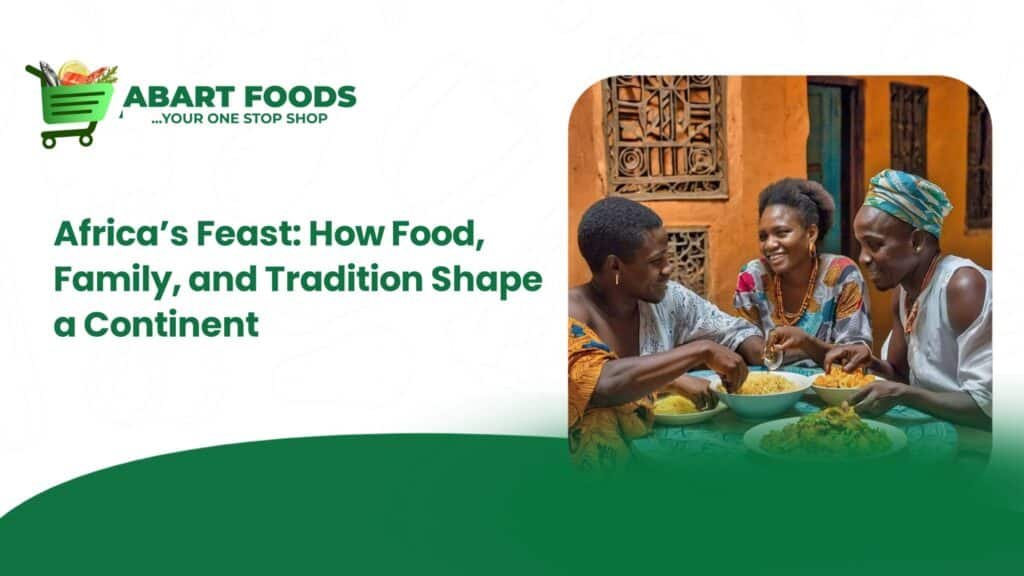Steam curls from pots in busy kitchens. Outside, cousins laugh while elders gather beneath an acacia tree, their voices filling the dusk. Plates loaded with spicy grains, slow-cooked meats, and leafy greens pass from hand to hand. In every region of Africa, sharing a meal is both a celebration and a memory made fresh.
Food here means more than just eating. Each bite holds stories passed down for generations—the wisdom of grandmothers, the joy of harvest, the spirit of togetherness. These family gatherings breathe life into tradition, bringing distant relatives and neighbors close, time and again. Across vast landscapes, it’s the simple act of sitting together at the table that weaves Africa’s many cultures into one.
North Africa: Spices, Storytelling, and the Sacred Table
From the bustling streets of Marrakech to Egypt’s sweeping deserts, North African kitchens are filled with rich aromas, lively chatter, and generations of laughter. Meals here are more than just food—they’re a chance to slow down, enjoy, and connect. The sound of pots and the smell of freshly baked flatbread are part of everyday life, bringing family, friends, and neighbors together around the table.
Photo by Andrea Musto
The Soul of North African Cuisine: Spices and Staples
Couscous grains cling together like a handful of sand, ready to soak up the flavors of saffron, cumin, and cinnamon. Tagines—a stew slow-cooked in deep clay pots—bubble with meat, vegetables, and sweet dried fruit. Warm flatbreads are torn by hand, never sliced, and passed from one person to the next.
Spices play the lead role in North African kitchens. They are both perfume and memory, gifted by ancient traders crossing the desert. You’ll find kitchens packed with:
- Cumin, coriander, and ginger for earthy heat.
- Cinnamon and cloves for a soft sweetness in savory dishes.
- Paprika and turmeric to give color and lift everyday meals.
- Saffron—prized for its subtle aroma and golden hue.
These flavors come together not just for taste, but for history. Trade brought new scents and ideas into local routines, tying North Africa to distant lands. To learn more about the journey and meaning of North African spices, visit this deep dive into the history of spices in African cuisine.
Shared Rituals at the Table
Here, a meal often starts long before anyone sits down to eat. In homes across Morocco, Algeria, Tunisia, and Egypt, families gather early to knead dough, soak couscous, and grind spices in heavy mortars. The kitchen turns into a stage as everyone joins—cousins chopping herbs, elders tasting broths, children sneaking pickles when they think no one is watching.
Important moments:
- Bread is baked fresh each morning and never wasted.
- Mint tea is poured from high above the cup—this isn’t just for show, but for cool bubbles and warm sweetness.
- On holy days and festivals, shared dishes hold lamb or fish, garnished with nuts, dates, and fresh herbs.
Meals are eaten together, often from a single large platter. This way, sharing isn’t just encouraged—it’s expected. Each reach and bite tells a story. These traditions are what bind North African families across distance and time. For a flavorful glimpse into the region’s signature dishes and the meaning behind every meal, explore this lively guide to North African food culture and traditions.
Storytelling and Sacred Hospitality
Across North Africa, the table is also a place for stories. Over tea, elders recount tales of desert journeys, old villages, and long-ago heroes. The act of eating links old memories to new, with every bite carrying a hint of the past.
Hospitality here is more than good manners. It’s a sacred promise—no guest leaves hungry or alone. Even strangers are fed before questions are asked. These values shape daily life and make every meal bigger than a simple gathering.
Want to see how food and hospitality shape daily life from the souks of Marrakech to the coast of Tunisia? You’ll find beautiful details in this piece on exploring the vibrant food of North Africa.
Every sprinkle of spice and every shared loaf is a reminder: in North Africa, food is memory, connection, and welcome all at once.
FAQs About North African Cuisine
North African cuisine is known for its bold flavors, aromatic spices, and use of fresh ingredients like olives, dates, and citrus. It blends influences from Berber, Arab, Mediterranean, and African traditions, making each dish a flavorful experience.
Popular dishes include tagines (slow-cooked stews), couscous, harira (a hearty soup), and bastilla (a savory-sweet pie). Each dish is rich in flavor and steeped in cultural tradition.
Spices like cumin, coriander, turmeric, cinnamon, and saffron are staples in North African cooking. Ras el Hanout, a spice blend, is also widely used for its unique mix of sweet and savory flavors.
Meals are often communal, served on large platters with bread instead of utensils. Sharing food is a cultural tradition that fosters connection and hospitality.
Flatbread is a daily staple, often used as a utensil to scoop up food. It symbolizes warmth, tradition, and community, as it’s frequently baked fresh and shared among family and friends.
Authentic North African ingredients, such as preserved lemons, harissa, and spices, are available at specialty grocery stores or online platforms like Abartfoods, which offers delivery options for convenience.

